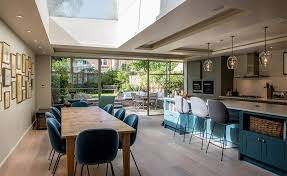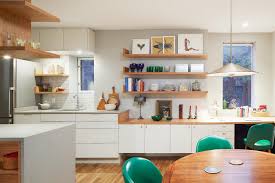What are the types of renovation?
Home renovation is very popular these days. More and more homeowners are choosing to stay in the same place, rather than purchase a new home. To make room for growing families and changing needs, home renovations are occurring at an ever-faster pace. There are five major types of renovations made by homeowners, whether the need is to update the home, add more space or simply make the home better reflect a family’s character and needs.
Kitchen Renovations
Renovating the kitchen is the most popular type of major renovation in a home. It’s also the best way to increase a home’s value if it were to be put on the market. Kitchen renovations can be done for numerous reasons – increasing usable space, updating appliances and cabinetry, or they can be done in concert with other renovations.
Bathroom Renovations
Bathroom renovations are generally not on the same scale as kitchen renovations, but as they can involve plumbing and render a bathroom unusable during the process, they are major considerations. Bathroom renovations offer the means to increase luxury within a home, and increasingly are done to help a family save water and electricity with green fixtures.
Basement Renovations
Finishing a basement is one of the best ways to add usable space to a home in North York. Basements can become full bedroom suites, or they might be used as movie rooms, game rooms, in-law suites or full apartments, depending on the needs. These major renovations can involve an immense amount of work and design, as well.
Additions
Adding a room (or more than one) is also very popular. Often, families with two or more children and not enough bedrooms choose to add on so each child can have their own bedroom. However, adding on can also be done if you want to leave the majority of the home alone, but want to add an office, family game room, sunroom or something else. These are major considerations, as the home’s internal structure will be altered during construction.
Adding a New Bathroom
For homes that have fewer bathrooms than is ideal, adding one is a very popular choice. This might be done to provide a private bathroom for children, or a guest bathroom that is not used by the entire family. However, because of plumbing considerations (and general construction), these are very major undertakings.

Loft conversions
Many homes across the UK, such as Georgian homes, Victorian terraces and modern homes, have an unused attic that can be converted into useable living space. This kind of extension or loft conversion allows you to add valuable square metres to the house’s floor plan while not encroaching on your garden space.
Loft conversions often require structural work, as the original house was most likely not built to hold the weight of a second storey. This means that loft conversions are typically more expensive than same level extensions, but they are nevertheless often the best option to add living space to a home, especially in denser, urban areas. Other factors that might add to the cost of a loft conversion include site access and waterproofing. This might be a good time to generally have your roof inspected and get any problematic areas fixed, or even have your house completely reroofed.
Key design issues to consider when converting a loft are windows and stairways. Skylight windows are more affordable, however, dormer windows create precious extra headroom. Generally speaking you’ll be working with a confined space, so smart storage solutions are worth incorporating. Costs for a loft conversion can vary greatly, depending on your house and your choices of materials and styles, but you should budget on at least £50,000 for a mid-level extension.

Types of home renovation: which ones boost the home value?
Home renovation is not simply an add-on to your loving home—it actually means a higher value for your property when it comes time to sell it. Now selling your house probably isn’t on your mine right now, but you always want to remember, “A House Is An Investment” so you have the opportunity to improve your investment as you renovate it. A renovated property, devoid of smudge marks on the wall, broken shelves and mould problem will fetch you a higher price when you sell it, right? Well, truly speaking, it depends. Suppose you are living in Iowa and engaged the finest home remodeling service Ames IA, still there is no guarantee that if you spent a fortune on renovating your house, you will end up getting a treasure in return. There is a strategic way of adding value to your house and you need to understand what type of renovation will get you more rewards.
Now, in this blog, we will understand which one will boost the home value if you are looking to sell your property.
- The Basics: The basics include basic features of a house that anybody and everybody will look for. Talk about properly functioning plumbing, non-leaky roof, solid floors, and even a working HVAC system. All these can be maintained with small repair jobs and you need not spend exorbitant amount of money to increase the value because they might not get the returns.
- Curb Appeal: These features, as you work on them, don’t always get too much of monetary value but they help the selling process becoming faster. As clear from the name itself, these features increase the appeal of the property and help in making the decision quicker for a prospective buyer. Things in this type of renovation will include well-maintained lawn, carpets that are clean, fresh paint and even nice-looking fixtures. A lot of homeowners add LED lights to make it more design-featured, and some very advanced gadgetry which turns the property into a smart home may also be included in this section.
- Value Added: Value added features or projects that give you maximum returns include kitchen renovations, new windows and new siding. At the same time, if you have searched on Google for “bathroom remodel Ames Iowa” and find somebody really good to work on your bathroom, it will most likely give you good dividends, along with energy saving features.
- Personal Preferences: As clear from the name itself, personal preferences are items that you have installed because of your own liking or need. Think of a swimming pool, a wine cellar, ponds, game room, and the likes. Though there is no harm if you have these things in your house but you can expect others to pay for these items separately because they might not like them or need them. So, if you are thinking of spending money to renovate these features, consider carefully.

What’s the Difference: Renovation vs. Remodel?
Understand the ins and outs of these similar but not synonymous projects so you can plan the right improvements for your home.
The words “renovation” and “remodel” are often used interchangeably, but if you’re planning some major home improvements, it’s best to get the terminology right before you talk to a contractor. While both renovation and remodel will improve and update your living space, the two types of projects are very different, each with its own set of benefits and considerations.
Renovation updates the look and feel of a room—or an entire structure—without changing its intended purpose.
In a renovation, a kitchen remains a kitchen and a bedroom remains a bedroom, but repairs and updates are made. This generally includes such things as painting, installing new flooring, and switching out items like cabinet knobs and faucets. Renovation also includes structural rebuilding. For example, if rotted wood members are discovered, they will be removed and the area (wall, subfloor, or roof) will be rebuilt using new lumber.
During a remodel, the design—and sometimes the structure—is altered.
Remodeling is the process of changing the functionality and the design of an area. It may involve tearing out a wall to expand a bathroom and reconfiguring a kitchen layout so the cabinets, fridge, sink, and range are in different locations. Constructing an addition to your home would also be considered a remodel. Remodeling need not always involve major structural changes, however; it can be something as simple as turning a guest bedroom into a home office. If the purpose of the area has been altered, it’s been remodeled.
Remodeling is often costlier than renovating.
Since remodeling may involve changing the physical structure of a home, it’s often necessary to reconfigure the wiring, plumbing, and ductwork, which makes the project more complex and pricey. More professional labor is usually involved in a remodel, and the material cost is often higher as well, since many remodeling projects involve building new additions. While the final cost comparison depends on the scope of the project and the quality of the materials, because renovations are usually less complex, they’re also easier on the budget.
Renovating may require pulling a permit, but remodeling almost always does.
Permits ensure that proper building codes are followed. Communities set their own rules, but it’s common for a local building authority to require a permit any time a structure is changed, including putting an addition on a home or tearing out and reconfiguring interior walls. Simple renovations, such as painting and installing new carpeting, don’t require permits, but replacing a roof (a renovation project because design and function are not altered) usually does. Reroofing is in a special category, because if a new roof isn’t installed correctly, it could leak and the home’s structure could be damaged, so most communities require permits for reroofing.